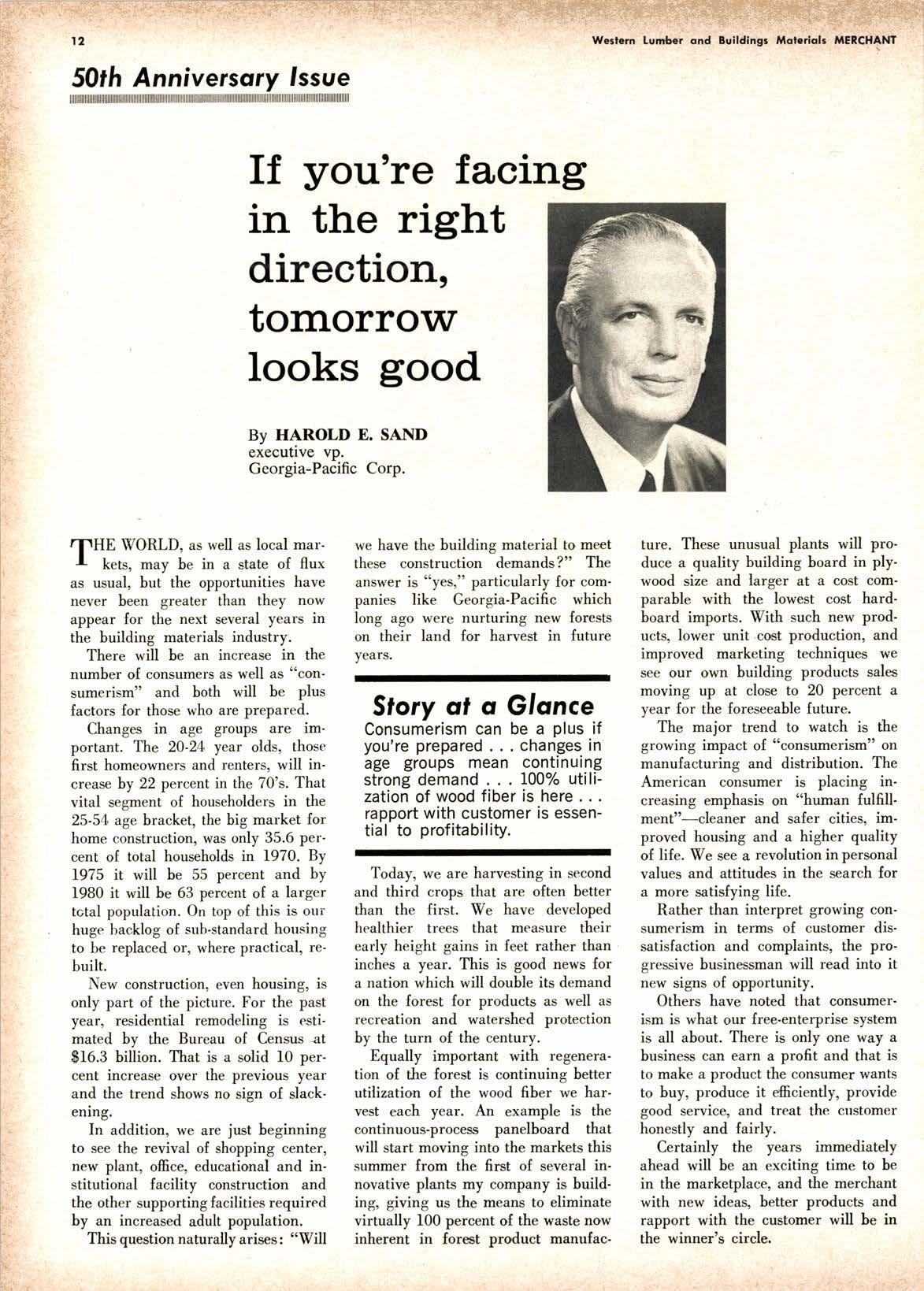
2 minute read
If you're facing in the right direction, tomorrow looks good
By HAROLD E. SA|ID executive vp. Georgia-Pacific Corp.
,THE WORLD, as well as local marI kets. mav be in a state of flux a. urual, but the opportunities have never been greater than they now appear for the next several years in the building materials industry.
There will be an increase in the number of consumers as well as ooconsumerism" and both will be plus factors for those who are prepared.
Changes in age groups are important. The 20-24 year olds, those first homeowners and renters. will increase by 22 percent in the 70's. That vital segment of householders in the 25-54 age bracket, the big market for home construction, was only 35.6 percent of total households in 1970. By 1975 it will be 55 percent and by l9B0 it will be 63 percent of a larger total population. On top of this is oui' huge backlog of sub-standard housing to be replaced or, where practical, rebuilt.
New construction, even housing, is only part of the picture. For the past year, residential remodeling is estimated by the Bureau of Census at $16.3 billion. That is a solid l0 percent increase over the previous year and the trend shows no sign of slackening.
In addition, we are just beginning to see the revival of shopping center, new plant, office, educational and institutional facility construction and the other supportingfacilities required by an increased adult population.
This question naturally arises: "Will we have the building material to meet these construction demands?" The answer is o'yes," particularly for companies like Georgia-Pacific which long ago were nurturing new {orests on their land for harvest in future years.
Story of o Glonce
Consumerism can be a plus if you're prepared . changes in age groups mean continuing strong demand . 100% utilization of wood fiber is here rapport with customer is essential to profitability.
Today, we are harvesting in second and third crops that are often better than the first. We have developed healthier trees that measure their early height gains in feet rather than inches a year. This is good news for a nation which will double its demand on the forest for products as well as recreation and watershed protection by the turn of the century.
Equally important with regeneration of the forest is continuing better utilization of the wood fiber we harvest each year. An example is the continuous-process panelboard that will start moving into the markets this summer from the first of several innovative plants my company is building, giving us the means to eliminate virtually I00 percent of the waste now inherent in forest product manufac- ture. These unusual plants will produce a quality building board in plywood size and larger at a cost comparable with the lowest cost hardboard imports. With such new products, lower unit.cost production, and improved marketing techniques we see our own building products sales moving up at close to 20 percent a year for the foreseeable future.
The major trend to watch is the growing impact of "consumerism" on manufacturing and distribution. The American consumer is placing increasing emphasis on "human fulfillmsn1"-slganer and safer cities, improved housing and a higher quality of life. We see a revolution in personal values and attitudes in the search for a more satisfying life.
Rather than interpret growing consumerism in terms of customer dissatisfaction and complaints, the progressive businessman will read into it new signs of opportunity.
Others have noted that consumerism is what our free-enterprise system is all about. There is only one way a business can earn a profit and that is to make a product the consumer wants to buy, produce it efficiendy, provide good service, and treat the crtstomer honestly and fairly.
Certainly the years immediately ahead will be an exciting time to be in the marketplace, and the merchant with new ideas, better products and rapport with the customer will be in the winner's circle.










